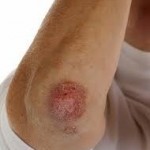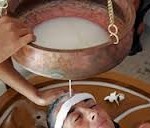AYURVEDIC TREATMENT FOR PSORIASIS
January 30, 2013 by admin
Filed under Tips for Ayurveda
 Psoriasis is a non infectious, inflammatory disease of the skin . Psoriasis is associated with dryness, itching, silvery scales on the skin and flakes on the scalp. Psoriasis can begin at an age of 20 or between 5 and 60 years too. It affects both the genders and the exact reason for Psoriasis is not known.
Psoriasis is a non infectious, inflammatory disease of the skin . Psoriasis is associated with dryness, itching, silvery scales on the skin and flakes on the scalp. Psoriasis can begin at an age of 20 or between 5 and 60 years too. It affects both the genders and the exact reason for Psoriasis is not known.
There is no treatment for psoriasis that can guarantee 100% result. Psoriasis is an auto immune disorder of the skin resulting in hyper proliferation of the skin especially at the elbows, knees, scalp. A natural psoriasis treatment that may help one person may have no effect on another person. Psoriasis treatment requires strict dietary restrictions and life style practices.
Ayurveda believes that impurities in the blood associated with emotional factors are the cause of the disease. Psoriasis known as Sidhma Kushtam is believed to occur due to vitiation of vata and kapha according to the ayurvedic concept. Irregular food habits, consumption of food items that cannot be eaten together for eg: diary products with fish, excessive intake of yogurt, black gram, seafood, jaggery ,sour and salted items etc can activate skin ailment. Alcohol and tobacco consumption will act as a catalyst here. Ayurveda emphasizes on the effect of stress which worsens the person affected by psoriasis.
Panchakarma treatment for psoriasis
 Panchakarma, the basic body purification method is used in the treatment of psoriasis. Ayurvedic treatment for psoriasis goes through several stages .
Panchakarma, the basic body purification method is used in the treatment of psoriasis. Ayurvedic treatment for psoriasis goes through several stages .
- Lepanam (application of ointments),
- Abhayangam (oil massage),
- snehapanam (taking medicated ghee),
- pizhichil (full body massage),
- avisnanam (medicated steam bath),
- sirovasti (keeping oil on head) and
- bastis (medicated enema).
Both systemic and topical treatments are used and can include drinking medicated ghee, purging and vomiting to detoxify.
- Detoxifying, by inducing vomiting (Vamana) and purgation (Virechana).
- Using medicated buttermilk dripping overhead (Dahara)
- Followed by pasting the entire body topically with a paste of medicines and mud,
- Finally medicated enemas (Basthi’s) are given for a week.
Internal medications in the form of herbal concoctions and medicated ghee has to be consumed for atleast three months.
Herbs used in Ayurvedic treatment for psoriasis
- Turmeric has anti-inflammatory and anti-bacterial properties and will help relive pain, reduce inflammation. Due to the antibacterial and anti-inflammatory properties of turmeric, it relieves the pain, swelling and inflammation associated with psoriasis, arthritis etc.
- Garlic (Allium sativum) – helps purify the blood and get rid of toxins
- Neem – purifies and detoxifies, helps the immune system and has antis, anti-bacterial and anti-fungal properties. It enhances immune system and neem oil is an antiseptic in itself. Will help with the redness and itching of psoriasis.
- Guggul a resin from a tree that grows in India it is anti-inflammatory and helps remove excess fats and fluids from the body. Kaishore guggul is useful remedy for psoriasis.
- Black Nightshade (Solanum nigrum)- Kakmachi – The juice of the leaves of the black nightshade can be applied locally on the affected regions. It helps in reducing the inflammation of the skin, and also has beneficial properties in minimizing discomfort and itching.
- Aloe vera: The gel extracted from the medicinal herb may be affected directly on the affected parts. The anti burn property is helpful to minimize itch and gives a cooling effect on the skin. Moisturizes skin and extremely helpful for plaque psoriasis.
- Jasmine (Jasminum polyanthum)–The flowers of the jasmine reduces pain, inflammation and soothes itching.
HOW TO REMOVE STRETCH MARKS NATURALLY
January 28, 2013 by admin
Filed under Tips for Ayurveda
 Stretch marks are caused by various reasons like sudden weight gain, losing weight, hormonal changes, puberty , pregnancy and when an individual strives for muscle building. This is experienced by few individuals only. It is very embarrassing as you need to change your dress styles, you are very conscious about stretch marks in different patterns and dark colors. Such marks tend to affect regions around abdomen, breasts, thighs, and upper arms.
Stretch marks are caused by various reasons like sudden weight gain, losing weight, hormonal changes, puberty , pregnancy and when an individual strives for muscle building. This is experienced by few individuals only. It is very embarrassing as you need to change your dress styles, you are very conscious about stretch marks in different patterns and dark colors. Such marks tend to affect regions around abdomen, breasts, thighs, and upper arms.
Stretch marks occur due to stretching, pulling and tearing of the dermis – skins middle layer . During pregnancy itching of skin especially on the tummy is very common. It is believed that the baby within is having thick hair. Avoid scratching skin, situation will worsen with more marks. After pregnancy when skin shrinks the stretch marks become predominant. The absence of collagen fiber also results in stretch marks for few. Initially it will be in reddish or purple color and gradually fade away with time after delivery.
Stretch marks affects the skin only , there is no other health issues. Since everyone desires to look their best here are a few home remedies to follow.
- Start paying attention to your skin at the early stages only. You need to apply a good moisturizer containing Vitamin E. Almond oil can be applied as Vitamin E adds to the development of elastin and collagen content of the skin, thereby serving to ease the stretch marks.
- Lavender oil and cocoa butter are also effective for minimizing stretch marks caused during pregnancy and lactation too.
- Try herbal alternatives, massage the affected areas regularly with oil extracts from wheat gram and olive , very effective for speedy easing out of stretch marks.
- Folic acid prescribed by most gynecologists during pregnancy and lactation also contributes majorly towards healing stretch marks.
- Regular moisturizing the skin during pregnancy will benefit to keep stretch marks far away.
- Oats is a natural scrub which minimizes stretch marks. Soak Oats for an hour and scrub over the areas
- Aloevera is rich in salicylic acid .A combination of olive oil and aloe vera in equal quantities is a good scrub and helps in removal of stretch marks.
- Remember stretch marks will totally fade away for a lucky few and will appear less significant for the people affected .
- To avoid itchy feeling of your skin take warm water bath and gently massage with oil. This will create a cover and you will get relief.
- Avoid usage of chemical creams and tubes to minimize stretch marks. The skin may react to these products and you will have irreparable damage of skin.
- Food rich in zinc, Vitamin C, protein and Vitamin K , serve to repair stretch marks. Thus citrus fruits, nuts, fish, milk, large helpings of green salad should be consumed abundantly to help ease stretch marks.
- Drink good quantity of water to keep body hydrated. It helps keep skin moisturized and minimize stretch marks.
- A home remedy for stretch marks goes as follows. Mix a pinch of turmeric in 10 ml of pure coconut oil. Apply this on stretch marks. The same remedy is recommended by ayurveda acharyas.
- Application of kumkumadi lepa or kumkumadi taila also helps to reduce the stretch marks.







